Goliath beetles are nature’s answer to the question, “What if bugs were built like bodybuilders?” These gentle giants are among the largest insects in the world, turning heads with their impressive size and vibrant markings. But keeping one as a pet? That’s not for the faint-hearted. They’re fascinating, rewarding, and—let’s be honest—a little demanding.
Whether you’re here out of sheer curiosity or ready to embark on your beetle-keeping journey, this guide covers everything from setting up the perfect beetle habitat to raising grubs into magnificent adults. By the end, you’ll be well-equipped to care for these spectacular insects and enjoy the process every step of the way.
Meet the Goliath Beetle: Nature’s Powerlifter

The Goliath beetle (Goliathus spp.) is a flower beetle hailing from the forests of Africa. Males grow up to an impressive 4 inches (11 cm) and sport a Y-shaped horn on their heads for wrestling food and wooing mates. Females, though hornless, are equally fascinating, especially with their vibrant, intricate markings that look like an artist’s masterpiece.
Fun fact: These beetles aren’t just eye candy. With proper care, they’re relatively low-maintenance, though beginners may find the process of raising them from grub to adult a bit of an adventure. Stick around, and I’ll show you the ropes.
Choosing Your First Goliath Beetle
Buying a Goliath beetle is like buying a car—you’ve got options, and it pays to know what you’re getting. Here’s what to consider:
- Adults vs. Grubs: Adult beetles are ready to go but pricey. Grubs, on the other hand, are cheaper but require months of care to reach adulthood. For beginners, I recommend starting with 3-4 grubs to account for potential losses. If you are buying adult beetles, verify the age of the beetles since they can only live for 6-12 months.
- Species and Morphs: Did you know some Goliath beetles have rare color morphs? The white morph (or quadrimaculatus) of Goliathus goliathus, for instance, is a collector’s dream but costs up to 10x more than standard beetles. Due to the high demand by hobbyists though, the white morph population in the wild is declining.
Pro tip: Always check for signs of health, such as intact limbs and smooth exoskeletons, when buying beetles. Ask sellers for care tips specific to the beetle’s stage of life.
Creating a Beetle Haven for the Adult Goliath
Goliath beetles need space to thrive, so let’s talk real estate. Here’s the blueprint for their perfect home:
- Substrate: Use coir, potting soil, or peat moss as your base. While they don’t eat it, they need a surface to walk and grip. Add bark or branches to help them right themselves if they flip over—a common beetle peril.
- Temperature: Keep the tank at 73-80°F (23-27°C). A heat mat can help during colder months.
Male goliath beetles are territorial and should not share a tank with other males or females.
Feeding Your Goliath Beetle

Feeding time is where the magic happens. Here’s what’s on the menu:
- Fruits: Bananas are a hit. Place them on a dish to avoid messy substrate cleanup. Replace daily to prevent mold.
- Sugar Syrup: Mix brown sugar and boiled water (3:1 ratio), soak it into a sponge, and voilà! Just remember to wash the sponge every 3-5 days.
Breeding Like a Pro
Breeding Goliath beetles is both an art and a science. Here’s how to ensure success:
- Mating: Introduce males and females post-pupation. After mating, separate the pair to prevent injuries and prolong their lifespan.
- Egg Laying: Gravid females need a deep, moist substrate to lay eggs. Expect 40-60 eggs, each resembling tiny white seeds.
- Raising Grubs: Grubs are protein-hungry creatures. Feed them koi fish food or dog food (low-fat preferred) and replace the substrate every two weeks to keep it clean.
Setting the Stage: Preparing Adults for Breeding
Before you start breeding, it’s crucial to ensure your adult beetles are healthy and ready for the process. Here’s how:
- Timing: Pair beetles right after they’ve emerged from their pupation cells. By then, they should be fully developed for mating. Delaying this too much may cause unsuccessful mating or weaker offspring as the beetles aged.
- Housing for Mating: Use a spacious enclosure to house the male and female together. Keep the environment at a steady 73-80°F (23-27°C) with good ventilation.
- Feeding for Strength: Provide a steady supply of beetle jelly and fresh fruit to ensure the beetles are well-nourished and energized for mating.
When the male is ready, he will climb onto the female and attempt to mate. Once the process is complete, promptly separate the pair to avoid injuries and prolong their lifespan.
Laying the Eggs: Setting Up the Nursery
Gravid (pregnant) female beetles need specific conditions to lay their eggs. Follow these steps for success:
- Preping the Substrate: Mix flake soil and peat in a 3:2 ratio. The substrate should be slightly moist—wet enough to hold its shape when squeezed but without dripping water.
- Nursery Housing: Use a 10-gallon (~38 L). Drill a few holes along the wall for ventilation.
- Depth Matters: Fill the container with at least 12 inches (~30 cm) of substrate. Compress the bottom 2-3 inches to create a firm layer for egg laying. This depth gives the female plenty of room to lay her eggs.
- Monitoring and Feeding: Continue offering beetle jelly or fruit, though the female may eat less during this period. Over the next few weeks, she will lay 40-60 eggs throughout the compacted substrate.
Caring for the Eggs and Hatchlings
Goliath beetle eggs typically hatch into grubs within 2-4 weeks. Here’s what to do:
Leave Them Be: Avoid disturbing the substrate too much. The eggs are delicate and need a stable environment.
First Instar Grubs: Once the grubs hatch, they will remain in the egg-laying substrate for the first few weeks. These early-stage grubs feed on the organic material within the substrate. You can transfer them to individual containers after their first molt.
Raising the Grubs: Protein Powerhouses
Grubs grow quickly and need a high-protein diet to reach their full potential. Here’s how to keep them healthy:
- Housing the Grubs: After the first molt, transfer each grub to its own 10 oz (~300 mL) container filled with moist flake soil. Grubs are territorial and can cannibalize each other if housed together. Drill a few ventilation holes on the container wall. Make sure your housing is covered tightly. Goliath beetle grubs are aggressive and are able to knock over the housing. I learned this the hard way when my first Goliath grub managed to escape and fell from a height, sustaining a severe injury.
- Feeding: Soften koi fish food pellets in water for a few minutes and add that to the substrate. Alternatively, use dog food with low fat content (need to be soaked longer). High-protein diets are essential but avoid excessive fat, which can lead to mites and feeding difficulties in the grubs. Experiment and give them enough food that can last for up to 4 days. Remove and replace the unconsumed food with fresh food to prevent growth of molt and reduce the chances of mite infestation. Do not leave the grubs without food!
- Cleaning and Substrate Replacement: Replace the substrate every two weeks. This prevents waste buildup and keeps the grubs comfortable. Wash the containers with mild soap and water during each cleaning.
- Growth Stages: After another 2 to 4 weeks, the grub will molt into the 3rd instar. They will stop feeding before molting. As they grow larger, move them to bigger a larger container (up to 100 oz/3 L for the third instar).
Because the female grubs tend to grow faster than male grubs, it is not uncommon to have a female beetle dying before a male beetle emerges. This can be prevented by regulating the temperature: keep your male grubs at higher temperature 78-80 °F (~25-27 °C) to accelerate his growth; Meanwhile, female grubs can be kept at 73-75 °F (23-24 °C) to slow down her growth.
But how do you know if the grub is male or female? To sex the goliath beetles grubs, look at the abdominal. You would notice a small dot on the ventral part of the last third segment of a 3rd instar male grub. This is not visible in the female grub. This dot is more conspicuous as the approaches the late 3rd instar stage.
Preparing for Pupation
It can take around 6-12 months for the grubs to turn pupae. Generally, female goliath beetles pupate earlier than their male counterparts. When you see the grubs start ignoring the food, wandering on top of the substrates and banging the container wall continuously, you should move it to a new container for pupation.
Here’s how to support this critical stage:
- Substrate for Pupation: Use loam that is half as moist as the previous substrate. Fill a 1.5-gallon (~6 L) container with at least 6 inches (~15 cm) of substrate and place the grub inside.
- Avoid Disturbance: Once the grub feels the substrates are suitable for pupation, it will start constructing a pupation cell. You should stop disturbing your beetle from now onward.
- Ventilation and Moisture: Ensure adequate ventilation and maintain low humidity by lightly misting the substrate as needed. Keep the substrate at most half as wet as the initial moisture of the loam. High moisture can kill the pupa.
If you are rearing multiple grubs, you can carefully remove the pupation cell from the loam 2 months after you last saw the grub. Place it together with other pupation cells in a ventilated container. Bury half of the pupation cell into moist substrates (eg. pesticide-free potting soil).
From Pupa to Adult

After 2-3 months in the pupation cell, the grub will transform into an adult beetle.
Certain beetle keepers will break the pupation cell during the dormant stage. This is because when the goliath beetle attempts to break the pupation cell, the pattern on its back might be scratched.
To do that, first, hold the pupation cell and slowly rotate it in your palm. Pay attention and feel if there is an object in the cell. If you feel something rolling as you rotate the cell, put the cell back and wait for 1 more week. Otherwise, carefully poke a hole on the pupation cell using an ice breaker. Be careful not to hurt the beetle.
Through the small hole you should be able to see the beetle. If it is indeed an adult beetle, carefully peel off the pupation cell like how you peel off the shell of a hard-boiled egg. Note that the pupation cell is quite hard. If it is still a pupa, put the pupation cell back and wait for a few more weeks.
Recommended Supplies
Ready to dive in? Check out my curated list of must-have supplies for Goliath beetle care. (Yes, these are affiliate links that help support this site!)
- Housing for adult beetle
- Substrates for adult beetles
- Beetle Jelly
- Nursery housing
- Housing for grubs
- Heat mat
- Thermometer & Hygrometer
Bonus Tips for Goliath Beetle Success
- Handling: Always hold beetles by their thorax, never their legs. This prevents injury to both you and your beetle.
- Mite Control: If you do encounter mites, dispose of all your substrates and thoroughly clean your container. Hold your grub under a slow running tap and brush it gently to remove all the mites before putting it back to the cleaned housing with new substrates.
Final Thoughts
Caring for Goliath beetles isn’t just a hobby; it’s a journey into the world of one of nature’s most fascinating creatures. From their grub stage to their glorious adult form, every step is an adventure.
Are you ready to accept the challenge? Your Goliath awaits! Leave a comment below with your questions or beetle tales—I’d love to hear from you.
Remember to check out our recommended books to learn more about goliath beetle keeping.


